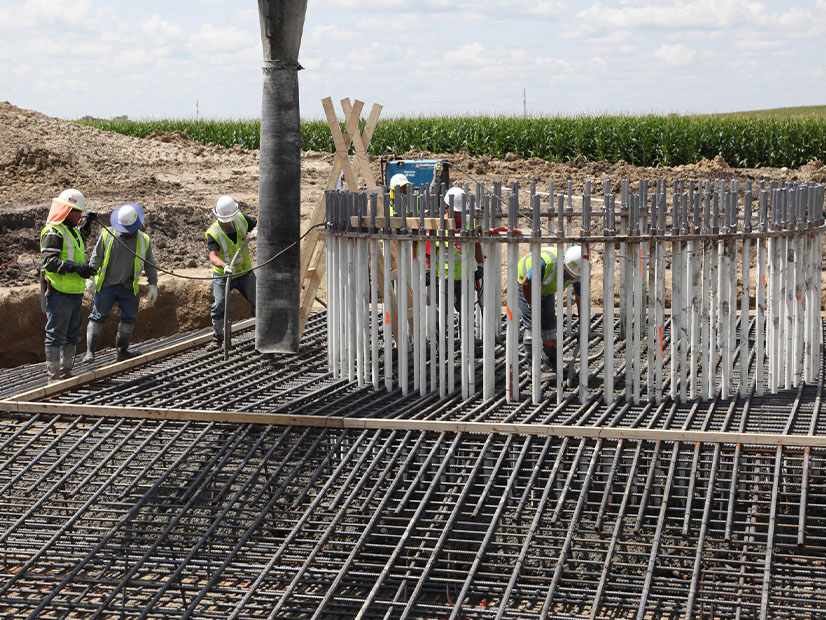
The proceedings will look into the practice by MISO, PJM, SPP and ISO-NE of allowing transmission owners to self-fund network upgrades needed to bring generation online, saying the practice may amount to favoring TOs over interconnection customers.
FERC on June 13 initiated show-cause proceedings into the practice by four RTOs of allowing transmission owners to self-fund network upgrades needed to bring generation online, saying the practice may amount to favoring TOs over interconnection customers.
The commission directed MISO, PJM, SPP and ISO-NE to explain within 90 days how their tariff language on the initial funding is fair or, alternatively, to propose changes to make their policies impartial (EL24-80). All four grid operators currently allow TOs the first shot at funding and earning a return on the capital cost of network upgrades required for generators to connect to their systems.
FERC said that approach might be biased against interconnection customers, who could see their interconnection service costs rise when compared with having the ability to finance their own upgrades. It said TO self-funding might “increase the costs of interconnection service without corresponding improvements to that service, may unjustifiably increase costs such that it results in barriers to interconnection and may result in undue discrimination among interconnection customers.”
The commission added that the grid operators’ current practice may amount to barriers to interconnection. It also seeks to “consistently and comprehensively” address the RTOs/ISOs that maintain a TO self-fund option.
Started with MISO
The Order to Show Cause is the latest in a string of seesawing decisions between the commission and the D.C. Circuit Court of Appeals that originated with disputes in MISO.
MISO restored TOs’ rights to self-fund in 2019 at FERC’s direction. The commission originally issued an order in 2015 preventing TOs from providing initial funding for network upgrades, but that decision was remanded by the D.C. Circuit. At the time, the court said the commission didn’t consider complaints from Ameren and five other TOs who claimed the policy forced them to accept “risk-bearing additions to their network with zero return” and essentially act as “nonprofit managers” of network “appendages.”
However, the court ruled in late 2022 that FERC did not adequately explain why it reinstated TOs’ option to finance network upgrades before the interconnection customers owning generation projects were given the chance to do the same. (See FERC Must Clarify MISO Tx Funding Decision, DC Circuit Finds.)
Since 2019, MISO interconnection customers have taken to filing unexecuted network upgrade agreements to protest the RTO reinstating TOs’ rights to self-fund. (See FERC Accepts Unexecuted Agreements Filed in Protest.)
Other affected grid operators have made filings regarding TOs’ right to self-fund upgrades.
PJM in 2021 filed on behalf of its TOs to replace its existing method of generator upfront funding of upgrades with a TO self-funding provision. The RTO also specified that interconnection customers must provide security either to PJM or the transmission owner in question to protect against non-payment. FERC accepted the switch but placed PJM’s new rules in a paper hearing and subjected payments to possible refund.
SPP allows either TO initial funding or generator upfront funding. However, FERC last year rejected an SPP proposal regarding its initial funding option, saying its plan to allow TOs a nonbinding decision to elect initial funding could create uncertainties for interconnection customers because a TO could reverse course at the end of interconnection studies, leaving customers with different network upgrade costs.
ISO-NE allows a TO to unilaterally elect initial funding. However, FERC said the practice of initial funding by TOs is rare in ISO-NE, where no TO has ever pursued the option. SPP in 2021 saw its first FERC-approved network upgrade agreement in which the TO elected initial funding.
In 2021, New York TOs filed a complaint against NYISO, which does not have an initial funding option, contending it was unfair the ISO wouldn’t allow them to be compensated for “the risks and costs associated with owning, operating and maintaining system upgrades.” FERC denied the complaint, reasoning the TOs didn’t demonstrate that NYISO’s current funding mechanism was inequitable.
‘Replacement Rate’
In its show-cause order, FERC singled out testimony from RWE Renewables, NextEra Energy and EDF Renewables, who argued that their costs “double or increase exponentially” when TOs take the reins on funding network upgrades. EDF claimed MISO’s use of TO initial funding has stymied development of new generation development in MISO and SPP, with larger MISO TOs hiking the cost of network upgrades.
FERC said it was concerned that unilateral TO initial funding might force an interconnection customer to pay a higher financing rate than it otherwise could secure through a lender. The commission also said interconnection customers may incur additional costs through securities to the TOs over a 20-year payback schedule.
“It appears that these increased costs do not provide any additional benefits to the interconnection customer than it would otherwise receive through generator upfront funding. We also are concerned that in some cases, an unjustified increase in costs may be significant enough to result in a barrier to interconnection because the costs are so high that projects that would otherwise be commercially viable cannot proceed,” FERC wrote.
Beyond that, FERC said it was troubled by the risk of discrimination to interconnection customers. It said vertically integrated TOs or TOs with affiliates may strategically decide to elect initial funding only for non-affiliate interconnection customers in an attempt to raise costs for competitors.
FERC also said it worried that initial funding may provide TOs the opportunity to double-dip on risk premiums because risks associated with owning, operating and maintaining network upgrades essentially are “baked-in” to TOs’ transmission rates, but also noted it might identify that TOs are not being adequately compensated for those risks.
The commission concluded the order saying that if it finds that TO initial funding is prejudiced but also finds that TOs take on uncompensated risks building network upgrades, it could enact a “replacement rate” compensation mechanism.



